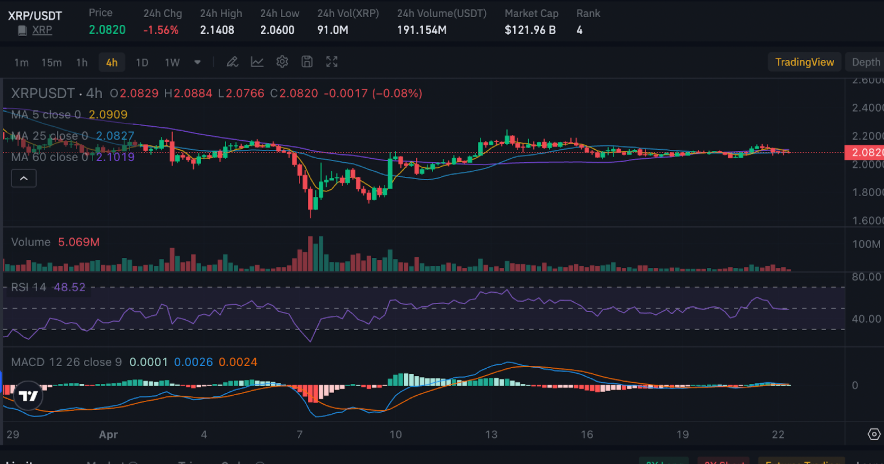
Why XRP Price USD is Important for Blockchain Adoption
The blockchain landscape has evolved significantly in recent years, with numerous cryptocurrencies vying for attention and acceptance in the global financial system. Among these, XRP (the cryptocurrency associated with Ripple) stands out as one of the most influential digital assets. While its core functionality revolves around enabling fast and cost-efficient cross-border transactions, its price in USD holds a much deeper significance in the context of blockchain adoption. In this article, we’ll explore why the XRP price in USD is a pivotal factor for the growth of blockchain technology, and how fluctuations in XRP price USDT could impact its role in the future.
Understanding XRP and Its Purpose
XRP is a digital currency designed to facilitate quick and inexpensive cross-border transactions. Unlike Bitcoin and Ethereum, which were originally created as decentralized digital currencies, XRP is part of the Ripple ecosystem. Ripple Labs, the company behind XRP, aims to revolutionize the financial sector by offering blockchain solutions that enhance the efficiency and transparency of international payments. XRP acts as a bridge currency, ensuring that transactions are executed rapidly while reducing costs and eliminating the need for intermediaries.
The Importance of XRP Price in USD for Blockchain Adoption
The price of XRP in USD is critical for several reasons when it comes to the adoption of blockchain technology. Let’s break down why the value of XRP plays such a vital role:
1. Financial Viability for Investors and Institutions
When considering any cryptocurrency, investors and financial institutions closely monitor the asset’s price. The XRP price in USD directly impacts the asset’s appeal to institutional investors, who are increasingly looking at cryptocurrencies as a potential store of value and a tool for portfolio diversification. Higher prices, or consistent growth, can signal a stronger, more stable blockchain ecosystem, thereby encouraging more institutions to consider using XRP in their operations.
For instance, Ripple’s partnerships with major financial players, such as Santander and PNC, would likely be influenced by the stability and growth of the XRP price in USD. The price of XRP serves as a barometer for the overall health of the Ripple network, thus directly impacting its ability to attract further partnerships, which in turn boosts blockchain adoption.
2. Market Sentiment and Public Perception
The XRP price in USD also heavily influences market sentiment and public perception of both Ripple and the broader blockchain ecosystem. A rise in the value of XRP may signify growing confidence in Ripple’s technology and its long-term viability, thereby driving broader adoption of blockchain solutions. Conversely, if the XRP price falls drastically, it may lead to negative sentiment around blockchain adoption in general, especially in markets that are already cautious about digital currencies.
Additionally, as blockchain adoption is still in its early stages, the public’s perception of cryptocurrencies like XRP is crucial. A strong and positive market performance can act as a catalyst for individuals, businesses, and regulators to become more accepting of blockchain technology.
3. Liquidity and Market Efficiency
XRP is often praised for its liquidity, which is one of the main reasons financial institutions prefer using it for cross-border transactions. The liquidity of XRP is largely dependent on its price in USD. When the price of XRP is stable and robust, liquidity in the market improves, making it more feasible for large-scale financial transactions to occur efficiently and without significant price slippage.
For the adoption of blockchain technology to expand beyond niche sectors, liquidity must be maintained or enhanced. If the price of XRP becomes too volatile, financial institutions may be hesitant to use it for critical applications, thus slowing down the rate at which blockchain technology is adopted.
4. Price Stability and Long-Term Viability
Blockchain adoption relies heavily on the stability of the underlying technology. The price stability of XRP is essential for maintaining long-term trust in its use case. If the XRP price in USD remains volatile and unpredictable, it could deter businesses from integrating blockchain solutions. In contrast, a consistent or gradually rising price would suggest a stable and sustainable ecosystem, which would encourage businesses to adopt Ripple’s blockchain for payments and other services.
5. Regulation and Legal Frameworks
The regulatory landscape for blockchain and cryptocurrencies is still developing, and the XRP price in USD could play a role in how regulators view Ripple’s ecosystem. If the price of XRP remains strong and continues to show promise, it may lead regulators to take a more favorable view of Ripple and the broader blockchain market. On the other hand, price drops or instability might prompt regulatory scrutiny, which could delay or even hinder the adoption of blockchain technologies.
Regulators often use market performance as one of the criteria for determining whether a technology is ready for widespread integration into traditional financial systems. A high XRP price USDT suggests confidence in Ripple’s technology, which could influence regulatory bodies to implement favorable policies for its adoption.
XRP Price USDT: A Key Indicator for Blockchain Adoption
In the world of cryptocurrencies, many traders use USDT (Tether) as a stable trading pair to assess the value of digital assets like XRP. The XRP price USDT is a reflection of how XRP is performing in relation to a stablecoin, which is pegged to the US Dollar. Tracking the XRP price USDT is critical for investors, as it allows them to gauge XRP’s value against a more stable currency, reducing the risks associated with volatile crypto markets.
Furthermore, the XRP price USDT is important for blockchain adoption because it allows businesses and financial institutions to convert XRP into a stable currency when needed. This facilitates smoother transactions and makes it easier for traditional financial entities to adopt blockchain technology without worrying about significant fluctuations in the value of the cryptocurrency.
Global Implications for Blockchain Adoption
The value of XRP and its relationship with the US Dollar through XRP price in USD has significant global implications for blockchain adoption. If XRP maintains or increases its value, it is likely to serve as a catalyst for blockchain technology’s widespread acceptance. This is particularly true in developing countries, where traditional banking systems often fail to provide efficient and affordable services. XRP offers a viable solution to these challenges, especially when its price remains stable and predictable.
In regions where financial inclusion is a major concern, the adoption of XRP and blockchain can create new economic opportunities. Countries with unstable currencies could benefit from adopting XRP as a medium of exchange, further boosting blockchain adoption on a global scale.
The Future of XRP and Blockchain Adoption
As blockchain technology continues to grow, so too will the role of XRP in shaping the future of the financial sector. The XRP price in USD will continue to be a crucial metric for gauging Ripple’s success and its influence on the broader adoption of blockchain. With increasing institutional interest, regulatory developments, and technological advancements, XRP’s price stability and growth will likely play a pivotal role in determining how quickly blockchain technology is integrated into mainstream finance.
FAQs
1. How does XRP differ from other cryptocurrencies?
XRP is designed specifically for fast and low-cost cross-border payments. Unlike Bitcoin, which is decentralized, XRP is part of the Ripple network, and its primary focus is on facilitating transactions for financial institutions.
2. Why is the price of XRP important for its adoption?
The price of XRP is a key indicator of investor confidence, liquidity, and market stability, which are essential factors for gaining institutional support and encouraging broader blockchain adoption.
3. What is the significance of XRP price USDT?
The XRP price USDT is a trading pair that allows investors to measure XRP’s value against the stablecoin Tether. This provides a more stable reference point for assessing XRP’s market performance and reduces exposure to price volatility.
4. How do fluctuations in XRP price affect blockchain adoption?
Significant price fluctuations can lead to market instability, discouraging businesses and financial institutions from adopting XRP and blockchain technology. A stable or increasing price, however, builds confidence in its long-term viability.
5. Can XRP contribute to global financial inclusion?
Yes, XRP has the potential to enhance financial inclusion, particularly in developing regions with limited access to traditional banking services. Its low transaction costs and fast processing times make it an attractive option for cross-border payments.
6. What role will XRP play in the future of blockchain technology?
XRP is poised to remain a crucial part of the blockchain ecosystem, especially in financial services. As blockchain adoption continues to expand, XRP’s value and utility will likely play a key role in shaping the future of decentralized finance.




